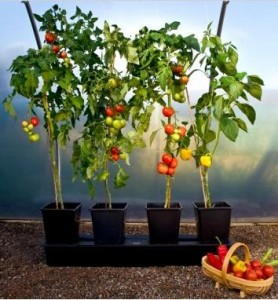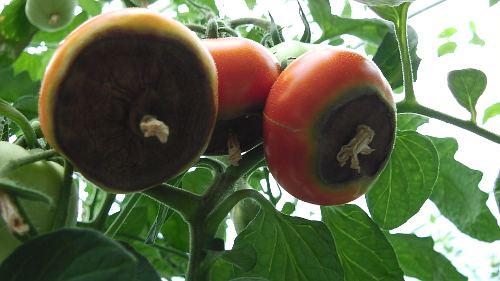In This Newsletter: The Wet/Dry Cycle In Tomato Growing, calcium and blossom end rot, feeding tomatoes and the benefits of a self watering planter.
The Wet/Dry Cycle in Oasesbox, Autopot, Quadgrow and Hozelock waterer.
Just to clarify … a wet/dry cycle is when soil is allowed to dry out (not completely) so that air can be absorbed back in between the soil particles.
The wet/dry cycle happens in a self watering planter like the Oasesbox or the valve supplied Autopot system.
The Quadgrow planter and the Hoselock waterer both use capillary matting to absorb water and they don’t have a wet/dry cycle.
It is not essential for good growth to have a wet/dry cycle if the system runs on the dryer side, so that air is always present.

Roots in the Quadgrow and Hozelock grow down into the reservoir so that the plants can absorb water at the speed they like.
The Oasesbox has a wet/dry cycle (if the water level is allowed to reduce before refilling), as well as openings for roots to access the reservoir.
The Autopot system has a wet/dry cycle provided by an aquavalve but the roots have no access to a reservoir and are totally dependent on the valve.
Using leaf mould for seedlings
Here’s a photo of Rhys’s seedlings growing in leaf mould. It’s a very good way of using old leaves from last season, disease free of course, and makes a good light mix for seedling roots.

Calcium and blossom end rot
Understanding that Blossom End Rot (BER) is caused by an interruption to the calcium supply, not necessarily a shortage of calcium in the soil.
This means that you could grow a tomato plant in 100% calcium (if it were possible) and still get Blossom End Rot.
So what causes an interruption to the calcium supply? Dry soil!
That’s why self watering planters with a good size reservoir are so helpful in avoiding BER – the soil never fully dries out – unless you forget to fill the reservoir of course!
If you find the info below about feeding tomatoes gets a bit too techie – read the words in bold for the main points!
Feeding Tomatoes
The reason why there is so much advice on this subject, especially on the internet, is partly because tomato plants require different amounts of food at different stages of growth.
To say that tomato plants require a lot of potassium (the main ingredient of tomato food) is true at the flowering/fruiting stage, but false earlier on in their growth.
With this in mind, here is a graph that shows the amount of nutrients required at the different stages of a tomato plant’s growth:

You will see that nitrogen and potassium uptake is initially slow but rapidly increases during the flowering stages.
Potassium peaks during fruit development, and nitrogen uptake occurs mainly after the setting of the first fruit/truss.
Phosphorus and secondary nutrients, Calcium and Magnesium are required at a relatively constant rate, throughout the life cycle of the tomato plant. (Source: Huett, 1985) http://www.haifa-group.com/knowledge_center/crop_guides/tomato/

So how does this apply to me … with a bottle of tomorite in one hand, a tray of seedlings in the other – stood over a grow bag?!
If you have ever wondered why (and been a little bit disappointed by the beefsteak tomatoes) large varieties tend to peter-out after the first truss, it is usually because after the first truss sets fruit, most home growers will be giving tomato food (high in potassium), rather than the boost of nitrogen that large fruiting tomato plants need.
It’s about energy … it takes a lot more energy to grow a large tomato than a cherry tomato and it’s nitrogen that provides the energy.
However, there is an issue here … the graph shows that nitrogen is not required in quantity until after the first flowers have opened.
Too much nitrogen before flowering, will delay flowering and you may end up with a lot of leaves – something like this:

A balanced food until the first truss has set, followed by a feed of nitrogen, then on to the tomato food after the second truss has set, is a good way to feed for medium and large tomatoes.
Why are beefsteak tomatoes more prone to blossom end rot than cherry tomatoes?
A large tomato requires more calcium to form the underside of the fleshy wall, than a cherry tom does.

The good thing is that tomato plants do not require a huge amount of calcium (see graph), just a regular supply – with emphasis on the regular!
If the soil dries out just once when the tomatoes are swelling, it will almost certainly cause Blossom End Rot in medium to large size tomatoes.
The main benefit of a self watering planter like the Oasesbox is its reservoir that keeps the soil moist 24/7.

If you would like to know more about the wet/dry cycle in tomato growing, please go here.
Let’s hope we have some better weather soon!
Best regards,
Nick

mick
hi nick, is it an advantage to use grow bags plus the planter. im going to try the planters getting 9 but have already got my grow bags will i have to water the bags as well?
Nick
Hi Mick,
The Oasesbox works well enough without grow bags but some people like to use extra soil because they can’t believe that tomatoes can be grown in smaller containers. The Oasesbox has the same soil capacity as the Autopot system – 8 ltr.
If you use grow bags then as long as you have good contact between the soil in the grow bag and the top layer of soil in the Oasesbox, you would only need to water the grow bag once or twice at the beginning. When the plants are established you would only need to water the grow bag if the soil in it became very dry.
peter.b
what is a regular amount of calcium powder ?.1 teaspoon to 10 ltrs multipurpose compost.
Nick
Hi Peter,
I wouldn’t add calcium powder to the soil directly but follow the instructions on the packet and water it in.
I can’t give amounts because it depends on the strength of the powder but the container it comes in should give details.
One option if you want to add calcium and magnesium is to add Dolomite Lime. The issue is that adding lime to soil raises the pH which may be helpful in some circumstances but tomato plants prefer slightly acid soil, so adding lime may reduce nutrient uptake.
My preferred method is to avoid adding it to the soil and foliar feed regularly with Chempak calcium when the toms are swelling.